AMAZON multi-meters discounts AMAZON oscilloscope discounts
Throughout this text we have tried to show some examples of the many waveshapes the technician will encounter in servicing receivers. It is very important for you to know, however, that because of the varying characteristics of chassis, probes and test equipment, waveshapes as seen on the scope can vary greatly.
For example, the horizontal sync pulse and the vertical sync pulse at the video stage of a properly adjusted TV chassis will have exactly the same height when pictured on a broad-band laboratory type scope through the use of a 1 0-to-1 capacitance divider probe. When a lower-priced service scope is used, however, he vertical sync pulse may have greater vertical amplitude than he horizontal sync pulse. This condition results from the fact hat the lower-priced scope may attenuate the height of the horizontal sync pulse (15,750 hz) which is of much higher frequency than the vertical sync pulse (60 hz.).
Waveshapes will vary not only with a change in testing instruments but also from TV chassis to TV chassis. Even using the same scope and probes, the technician will encounter different waveshapes as he tests similar circuits. Service technicians should spend as much time as possible, therefore, in getting acquainted with test instruments and with the waveshapes of the more popular TV chassis.
It is good servicing technique to use a scope and probes to race the signals throughout the different stages of a properly functioning TV chassis. You should make it a point to view wave-shapes of circuits peculiar to each popular chassis. As you make such a study, sketch the waveshapes for future reference. Once you have on paper a representation of the waveshapes of a properly functioning TV chassis, you will have a basis of reference when servicing these receivers.
Each chassis and model of the same manufacturer will have waveshapes which will deviate somewhat from a typical sample for this particular chassis because of modifications in receiver components and because of production adjustments. We suggest, therefore, that the service technician make waveshape sketches of two or three different chassis of each model to get acquainted with the variations that may be expected.
With the scope and probe the technician can make measurements that are absolutely impossible with any other known technique. The value of this knowledge is completely dependent upon your ability to interpret what you see on the scope. Efficiency in the use of the scope and probes will depend entirely on acquaintance with waveshapes encountered in servicing TV receivers.
The same reasoning applies to the measurement of d.c. voltages. Voltages at various test points in a receiver will depend upon the sensitivity of your test instrument and the circuit in which the checks are being· made. For example, in a high-impedance circuit the voltage indicated on your test meter might actually be lower than the operating voltage.
Television waveforms It might very well seem to the service technician that because of the many variables involved, servicing by waveform inspection would be a hopeless task. You can reduce it from the status of a guessing contest by keeping a record of waveforms you have observed and also by comparing the waveshapes with those seen on a wideband laboratory type scope. The illustrations that follow were taken from a representative, modern TV receiver using a scope designed to show the waveshapes as they actually exist. By using these illustrations as a guide you will be in a better position to interpret what you see on your own scope.
Waveforms in TV receivers
Interpretation of waveforms is not always an easy matter. When an auxiliary receiver is available, comparison checks can be made back and forth between the faulty receiver and the normal receiver. When an auxiliary receiver is not available, the technician may have trouble because Fig. 1 of the incompleteness of the published data. In many cases the waveform and peak-to-peak volt 6e may check out correctly, but the circuit action will still be faulty because of minor spurious components in the waveform.
Whether or not such minor spurious components are tolerable cannot be determined when the published waveforms are Fig. 2 sketched rather than photo graphed; the technician making the sketch almost always deletes minor components which may be present in normal operation.
In Fig. 1 we have the setup in progress for the examination of waveforms in a TV receiver. The receiver is attached to the scope through the probe. In this picture, the low-capacity probe is being connected to the sync separator. The scope (Tektronix 524D) is set to external sync and is connected to the output of the integrator. The receiver is a Magnavox, series l05. Most of these pictures were taken with this equipment. Figs. 13, 14, 16, 22 and 23 courtesy of G-E Techni-talk.

Fig. 1- Fig. 2
When the desired waveform is obtained, the probe is kept in place by means of a clip which slips on to the probe tip. The 35 mm camera and its housing are then placed over the face of the scope. The only light for the film comes from the scope. A small viewer allows examination of the scope trace up to the moment the picture is taken. In this picture (Fig. 2) sync amplifier waveshapes are being checked.
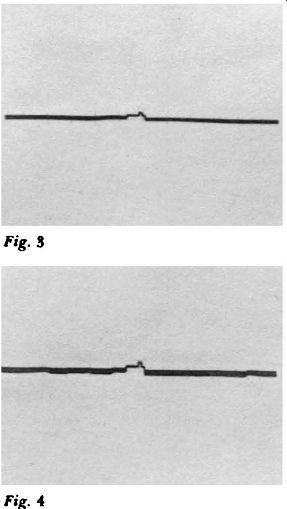
The photo in Fig. 3 shows the output of the v.h.f. tuner (control grid of the first video i.f. stage). The probe used here is a crystal demodulator type.
Fig. 4. Output of the v.h.f. tuner taken at the control grid of the first video i.f. stage using a crystal-type voltage-doubler probe.
Note the higher deflection.

Fig. 5. The probe is now at the plate of the second video i.f. tube.
In examining TV waveforms, set the scope sweep for 30 hz. and then readjust the sweep for 7,875 hz. These figures represent one half the vertical and horizontal oscillator sweep frequencies in the TV set.
Fig. 6 shows the plate of the second video i.f. tube as viewed with a voltage-doubler probe.
Note the higher deflection voltage that this probe gives. This is particularly useful when checking weaker or smaller peak-to-peak voltages. Voltage-doubler probes (crystal type) are described beginning on page 51

In Fig. 7 we have the wave form at the control grid of the third video i.f. Note difference in amplitude between this wave and that shown in Fig. 3. Since we are working our way toward the picture tube, the amplitude of the waveform is increasing. The probe used here is a crystal de modulator type.
Fig. 8 shows the waveform at the plate of the third video i.f.
The vertical sync pulse has a greater peak-to-peak amplitude than the horizontal sync pulses.
This is due to the attenuation of the high-frequency response by the cable and scope input capacitance.
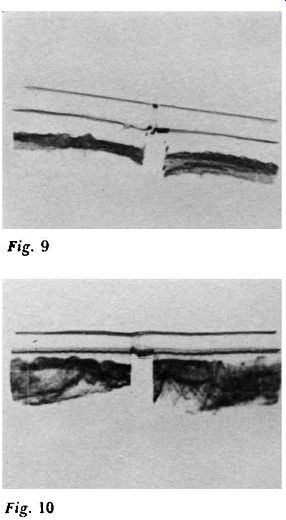
Fig. 9 shows the signal as it appears across the detector load resistor. In this instance the signal had a value of 2.6 volts peak-to peak. The scope sweep was set to 30 hz.
In Fig. 10 we have the composite video signal. Note the relative amplitude of the blanking and sync pulses, and picture component. The horizontal sync pulses have the same peak-to-peak value as the vertical-sync pulses.
Because of the limited high frequency response of some service scopes and because of the high-frequency attenuation due to the capacitance of the scope cable, the high-frequency horizontal sync pulses and video component usually appear much lower in amplitude than the lower frequency vertical pulses.
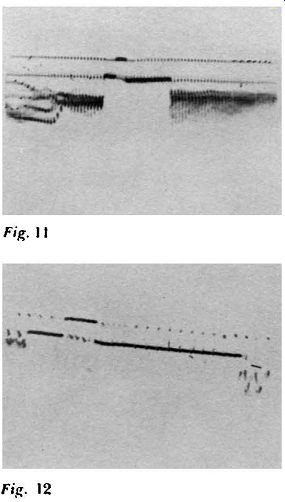
Fig. 11 - Fig. 12
Fig. 11 is the same illustration as Fig. 10, except that the wave form has been expanded three times. Note that the pulses can now be defined instead of appearing as two solid lines.
Fig. 12 is the same as Fig. 10, except that the waveform has now been expanded ten times. The horizontal sync pulses are spaced wider than the equalizing pulses.
Note that the vertical sync pulse consists of six separate pulses at the equalizer pulse rate.
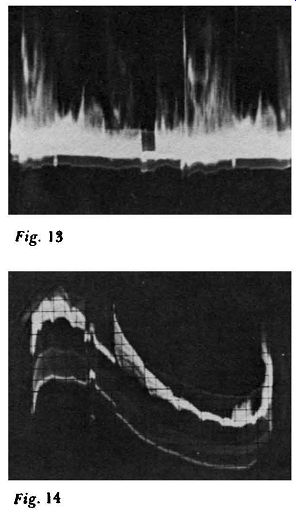
Fig. 13 shows a defective video signal. The sync pulses are highly compressed. Lack of stability in the vertical and horizontal sweep circuits should now be checked back through the video amplifier and picture detector stages.
Fig. 14 shows 60-cycle hum pickup in the video signal. Make sure that the hum modulation actually exists in the receiver, that it is not due to hum pickup in the test leads and that the scope is properly connected and grounded.
Fig. 15 shows the waveform as it appears at the control grid of the first video amplifier. The horizontal sync pulse is generally visible only with a laboratory-type scope.

In Fig. 16 we have another picture of the composite video signal. This is the waveform as seen in the output of the video amplifier. If the sync pulses have full amplitude here but you have vertical or horizontal instability, trace the pulses through the sync separator and amplifier circuits.

Fig. 17 shows the waveform as it appears at the plate of the first video amplifier. The waveshape contains vertical and horizontal sync pulses, plus video information. The amount of voltage depends on the strength of the TV signal. Some receivers use an additional video stage to build up the composite video signal.
The input signal to the control grid of the sync separator (see Fig. 18). The signal contains vertical and horizontal sync pulses and still carries the video information.
The sync separator removes that part of the composite video signal below the blanking level.
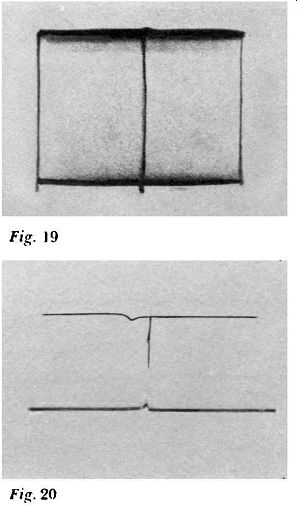
In Fig. 19 we have the pulse at the plate of the sync clipper. The pulse is 22 volts peak-to-peak. The scope sweep was set for 7,875 hz.
In Fig. 20 we have the signal as it appears at the plate of the sync amplifier tube. The video portion of the signal has been stripped away, leaving the vertical and horizontal sync pulses. These pulses will be separated by integrating and differentiating net works.

Fig. 21 illustrates the wave at the cathode of the sync clipper.
Here the pulse is 2.5 volts peak-to peak. Scope sweep set for 30 hz.
In Fig. 22 we have a normal sync waveform. For proper triggering of the vertical and horizontal oscillators, the sync pulses should be well clipped and free of video information.
Sync pulse output showing some video information remaining is illustrated in Fig. 23. The presence of the video signal indicates poor operation of the sync separator or clipper and results in poor synchronization.

In Fig. 24 we have the vertical sync spike at the output of the integrator network. The integrating network is a low-pass filter, has a relatively long time constant. The output of the integrating network is used to trigger the vertical oscillator.
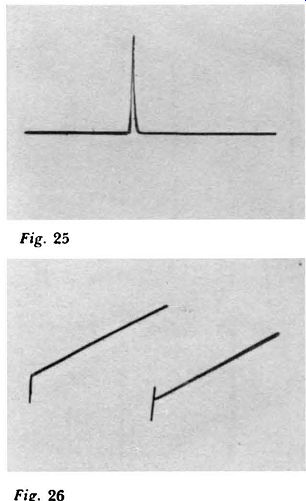
Fig. 25. This show~ the wave form at the plate of the vertical multivibrator.
Fig. 26. Waveform as it appears at the plate of the vertical discharge tube. Note the square wave component at the beginning of the sawtooth.
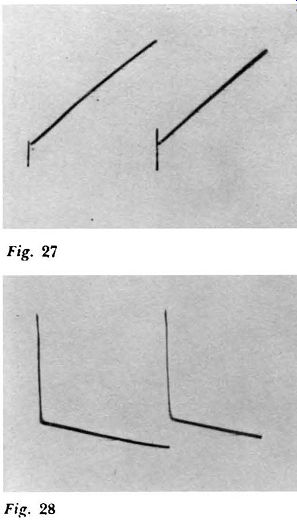
Fig. 27. Waveform at the control grid of the vertical output tube. Note the presence of the square-wave component at the beginning of the sawtooth. This voltage is 18 volts, peak-to-peak, scope set at 30 hz.
Fig. 28 shows the waveform at the plate of the vertical output tube. Note that the square wave component is now much greater than that shown in Fig. 26 and Fig. 27. This is introduced purposely to correct for the reactance of the vertical-output transformer and the deflection yoke. The pulse is 750 volts peak-to-peak. Scope is set to 30 hz.
In this illustration (Fig. 29) we have the waveform as it appears at the yellow lead of the vertical deflection coil. This wave is 120 volts peak-to-peak. The scope sweep is set for 30 hz.

Fig. 30 shows the vertical re trace blanking waveform. This wave was observed at the control grid of the picture tube. In this instance the cathode of the picture tube was the signal electrode.
The waveform is 12 volts peak-to peak. Scope sweep is set at 30 hz.
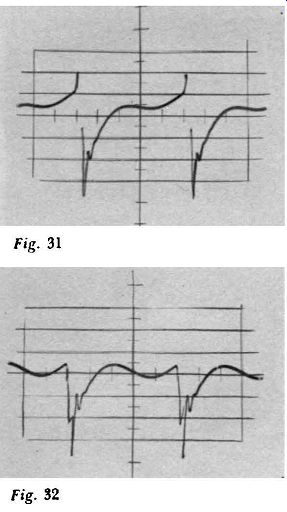
This illustration (Fig. 31) shows comparison voltages be tween the horizontal oscillator and sync spike. The sync spike is sharp. Adjustment to the speed coil should be made only when on transmitting sync. Assuming nor mal operation of the TV receiver, the waveforms on these pages often do not appear as shown.
This is a function of the type of scope and cable that are used.
Fig. 32 is essentially the same as the waveform illustrated in Fig. 31. The decreased amplitude is due to a lower setting of the attenuator control of the scope.
When examining waveforms on your scope try to get the wave at the center of the screen. A certain amount of distortion may appear in the wave when it is at the extreme left or right hand side of the scope tube.
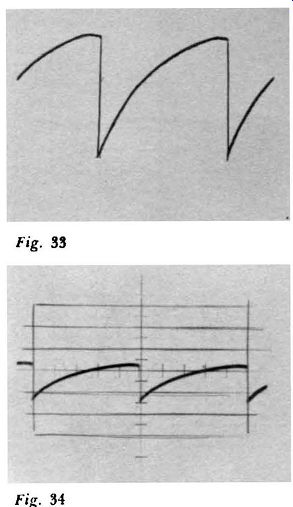
Sawtooth in the input circuit of the horizontal amplifier is shown in Fig. 33. It is permissible to have certain nonlinearity at the beginning and end of the saw tooth, often purposely introduced to compensate for the reactance of the deflection coils in the yoke.
In Fig. 34 we have a photo of the sawtooth input to the control grid of the horizontal output tube. This waveform is exactly the same as that shown in Fig. 33 except that the vertical gain control of the scope was not advanced quite as much. This shows clearly how dependent the wave shape is upon settings of the scope controls.
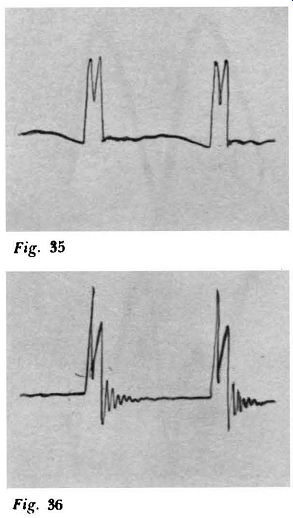
Fig. 35 shows the waveform at the plate of the horizontal output tube. An ideal waveshape would be a single spike, but this is seldom found. The peak pulse usually ranges from 3 kv to 6 kv.
Fig. 36 shows pulses as they appear at the plate of the a.g.c.
amplifier tube. Note that this photo has considerable resemblance to the waveform shown in Fig. 35. The pulses at the a.g.c. amplifier plate have a frequency of 15,750 hz. and a peak-to-peak amplitude of about 450 volts.
Scope set at 7,875 hz.

In the photo, Fig. 37, we have the waveform showing the input to the horizontal deflection winding of the yoke. Note the absence of ringing transients which could be introduced by the yoke due to an impedance mismatch.
Fig. 38 shows the waveshape as it appears at the plate of the damper tube. The damping tube prevents continuation of transient oscillations in the horizontal out put sweep circuit. Most damper tubes are diodes although triodes are used occasionally. The vertical deflection system generally uses resistive damping.
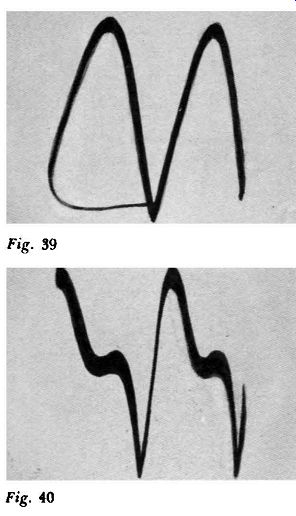
The waveform at the cathode of the damper tube is shown in Fig. 39. Here the waveform is 50 volts peak-to-peak. The scope sweep is set for 7,875 hz.
Fig. 40 shows the horizontal linearity output. The waveform is 40 volts peak-to-peak. Scope sweep was set at 7,875 hz.
AMAZON multi-meters discounts AMAZON oscilloscope discounts